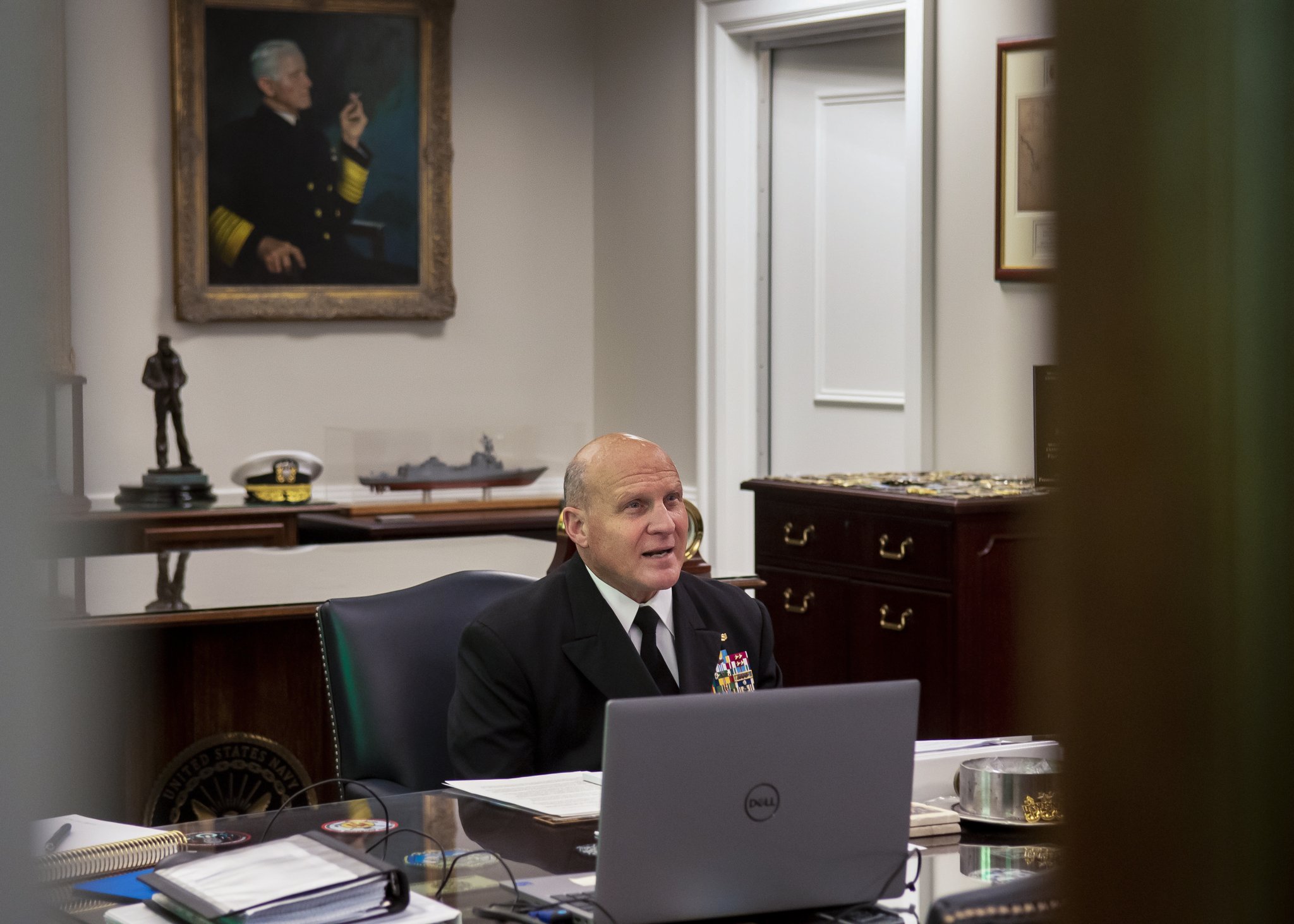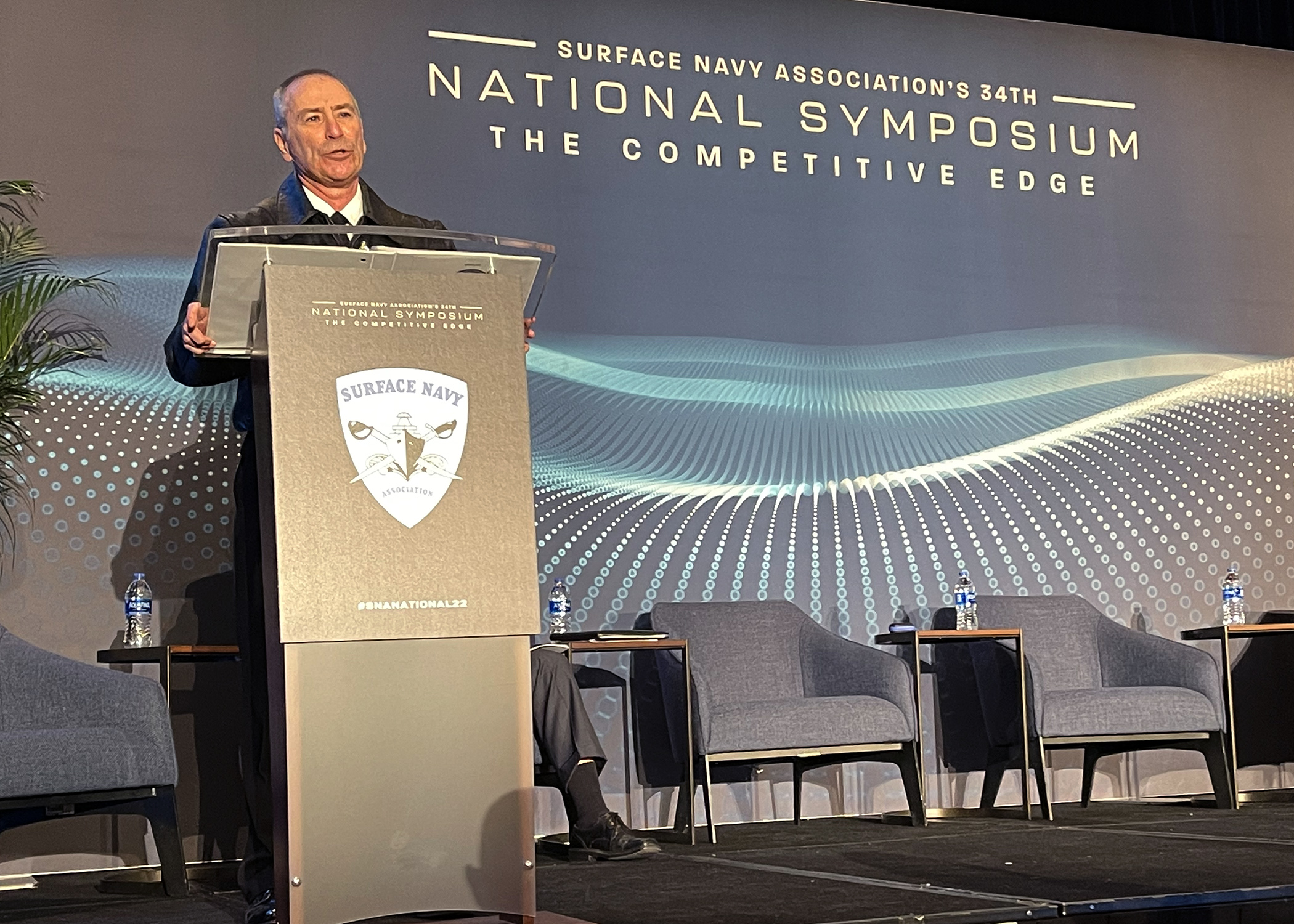
ARLINGTON, Va. – The reluctance across the Navy to be self-critical and a tendency to hide mistakes and minimize flaws have resulted in systemic problems in the service and stalled efforts to improve, Chief of Naval Operations Adm Mike Gilday said on Tuesday.
“We are not operating to our full potential. Over these last few years, I think we have learned some hard truths about ourselves,” Gilday said in a speech broadcast to the Surface Navy Association symposium.
“We have seen examples of significant organizational drift – instances of unsatisfactory unit performance, late completion of shipyard maintenance availabilities and failure to deliver game-changing, innovative technologies and concepts at pace.”
Gilday highlighted the inconsistency in performance from unit to unit. Those faults contributed to public failures, like the 2020 fire aboard the former USS Bonhomme Richard (LHD-6), which showed that sailors and their commanders weren’t ready to fight a fire on a ship undergoing maintenance.
“The gap between our most and least capable performers is too large. There is unacceptable variability in our performance. This variability cuts across different units, organizations, and communities, both at sea and ashore,” Gilday said.
“At the lowest end of the performance spectrum, we see tragic results like the Bonhomme Richard fire – along with 14 other major fire events in the last 12 years and excessive cost and schedule overruns in key acquisition programs.”
Gilday’s proposed fix is to have commanders and sailors be more realistic about their performance and not ignore or minimize problems.
“The solution lies in focusing on how we can be more self-assessing and self-correcting so that we identify problems before they grow into larger, more systemic issues,” Gilday said.
“Every Navy leader must be ruthlessly honest in how they self-assess and understand their unit’s performance. They have to act boldly and embrace professional risk, elevate problems, welcome transparency, clearly articulate their challenges and leave their egos at the door. If our performance is not as good as we thought, we do not hide our assessment or ‘keep it inside the lifelines.’”
Part of that effort will be to install a two-star – who reports directly to the CNO – in charge of the emerging Navy Safety Command. Creating this new position is one of the recommendations from the Major Fires Review report following the Bonhomme Richard fire investigation. Gilday also alluded to coming Navy organizational changes that will contribute to the cultural shift.
“The critical imperative here is that the self-assessment culture and tools must be widely adopted across the Navy. I expect every sailor to adopt this mindset. Anything less would shortchange our team and our teammates,” he said.
The speech comes in parallel to Gilday issuing a new Charge of Command to the Navy – the guidance given to commanders from the CNO – that encourages commanders to ask for help and not hide mistakes.
“Strategic competition requires every organization to improve, to thoughtfully experiment, to learn and get better every day. Do not be content with the status quo performance you inherit. Know precisely where you and your team are, identify where you need to be, and then develop and execute a plan and learning path to get there. Identify specific barriers constraining performance improvement or mission accomplishment. Elevate to your chain of command, without undue delay, the barriers you cannot resolve internally or through collaboration with your peers. Clear communication about these barriers is a critical exercise of integrity,” Gilday wrote in the document.
“Value effort-based mistakes as an opportunity to improve, providing both subordinates and subordinate Commanders the latitude to make and learn from their decisions.”
Gilday promised reforms in how the service would better absorb into the fleet lessons from disasters like the fatal destroyer collisions in 2017 and the Bonhomme Richard fire.
“How we share learning and solve problems across the Navy… has focused too long on instructions rules and checklists,” he said.
“As an institution [we] have not routinely absorbed lessons in a way that truly endures. When something bad happens we often view poor performance as a one-off failure, put short-term adjustments in place and apply burdensome regulations, guidance, and oversight.”
“We need to do better and apply the lessons of our hard-earned experience.”
Surface Specific

Meanwhile, Naval Surface Forces commander Vice Adm. Roy Kitchener on Tuesday formally unveiled a new strategic vision for the surface force.
“Surface Warfare: The Competitive Edge,” lays out multiple lines of effort to have more ships ready for tasking and do a better job training its sailors.
Kitchener declined to provide the number of ready ships the Navy needs, arguing the service has more work to do. But he said the number is helping the Navy get a better picture of the surface fleet enterprise, from ships to spare parts.
“What I think is so valuable about the number is one, it allows us to understand, okay besides for the normal production through [the Optimized Fleet Response Plan], what else do we have to use for other missions? But most important, it allows us to start getting after understanding what does it cost to maintain this many ready ships? Or is it a lower number? Okay, this is what it would cost to do that. Is it a higher number? And so that’s sort of what’s driving us that helps us understand what spares do we need? How much do we pay for those? How much maintenance do we need to do? And so I see it as a full spectrum. It’s really helping us understand our enterprise.”
After using data to assess the readiness of its surface ships, Kitchener said the Navy is considering a readiness rating system similar to how naval aviators evaluate aircraft readiness.
“We are looking at – and I’ll use these terms loosely – full-mission capable, mission capable and non-mission capable,” Kitchener said.
While the Navy uses OFRP to generate Navy tasking for the combatant commanders, Kitchener said he wants the surface fleet to evaluate what assets would be available for other tasking.
“The whole goal is to see.. ‘Ok, here’s what I can provide Navy and fleet commanders [Global Force Managemen]-wise and then here’s what else is there for sustainment. And then is there something else we can offer and here’s what it would cost? Or do you want something less?”
Another line of effort under Kitchener’s vision is creating infrastructure for the future fleet, which includes an artificial intelligence initiative called Task Force Hopper.
Kitchener’s document calls for his team to produce “initiatives with a ten-year horizon, to include a digital infrastructure roadmap, integrated with other TYCOM AI/ML Task Forces, and scope required resources to support digital efforts” for the task force by June 2022.





